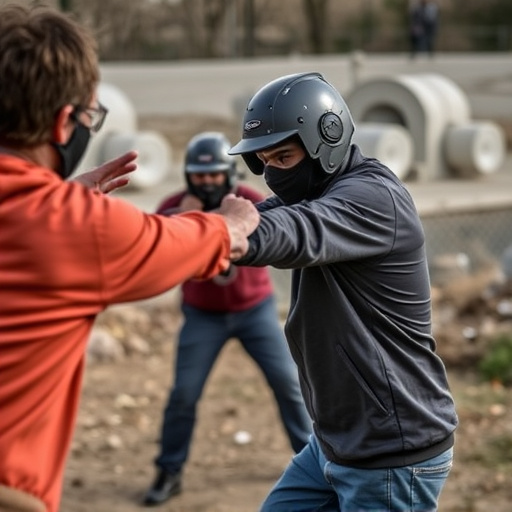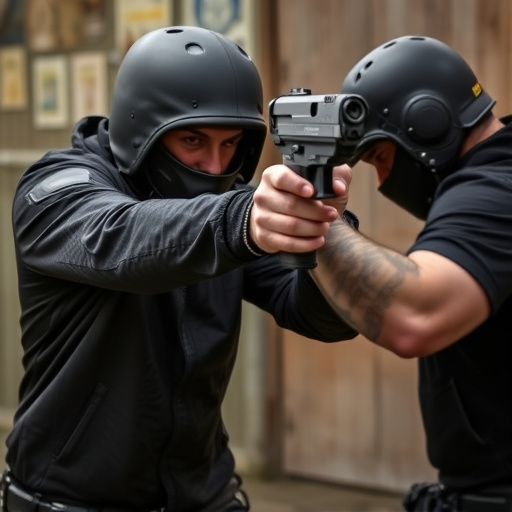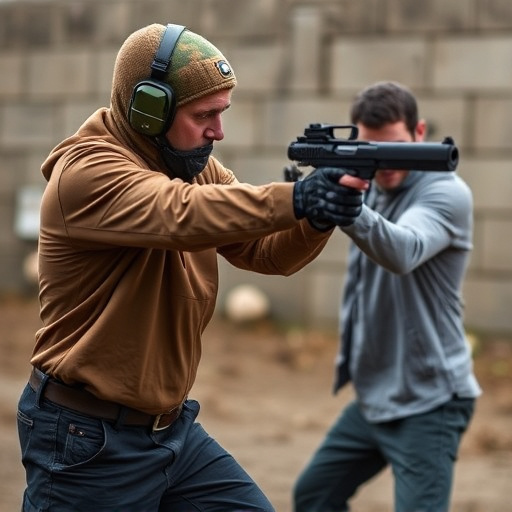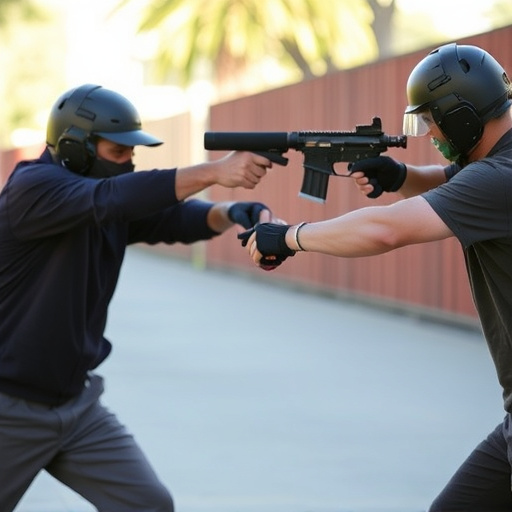Lipstick-sized stun guns, compact enough to fit in purses, offer discreet self-defense capabilities with high shock potential. The duration of their paralysis effect varies from seconds to minutes, influenced by factors like Taser model and individual's physical traits. While convenient, users should be aware of health risks, including cardiac issues and prolonged numbness, which require immediate medical attention. Strict guidelines govern their use to avoid legal issues; responsible ownership includes training in de-escalation, device features, storage security, and understanding temporary paralysis limits.
“Tasers, known as stun guns, have gained popularity as compact self-defense tools, especially their lipstick-sized variants easily concealable in purses. While their effectiveness is debated, understanding the duration of paralysis they induce is crucial. This article delves into the effects of Taser deployment, focusing on paralysis duration—how long it lasts and its medical implications. We explore key considerations for responsible ownership, including training, safety measures, legal rights, and post-use care, providing insights for informed decisions.”
- Understanding Taser Deployment and Its Effects
- The Lipstick-Sized Stun Gun: A Compact Self-Defense Tool
- Paralysis Duration: How Long Does It Last?
- Medical Considerations After Taser Use
- Legal Implications and Rights of Individuals
- Training and Safety Measures for Responsible Ownership
Understanding Taser Deployment and Its Effects

Taser deployment, often used by law enforcement as a non-lethal force tool, involves firing two small probes connected to high-voltage electrical currents. These probes penetrate the skin and deliver a powerful jolt, temporarily paralyzing the targeted individual. The effects of a Taser strike can last for several seconds up to a few minutes, depending on various factors such as the model used and the body’s electrical conductivity. It’s worth noting that modern Tasers, known as “lipstick-sized stun guns” due to their compact size, pack a significant punch while remaining easily concealable in purses or pockets.
While designed to subdue individuals without causing permanent harm, the duration of paralysis can vary. Factors like the person’s physical condition, clothing, and body fat percentage can influence how long the effects last. In some cases, individuals may regain mobility almost immediately after the Taser is disabled, while others might experience a longer period of weakness or disorientation. Understanding these variables is crucial in assessing both the effectiveness and potential risks associated with Taser deployment as a law enforcement tool.
The Lipstick-Sized Stun Gun: A Compact Self-Defense Tool

The Lipstick-Sized Stun Gun: A Compact Self-Defense Tool
In today’s world, personal safety is a top concern for many individuals, especially when they’re alone or in unfamiliar places. This has led to the development and growing popularity of compact self-defense tools that are easy to carry and readily available. One such innovation is the lipstick-sized stun gun designed specifically for purses or pockets, offering a discreet yet powerful means of protection.
These miniature stun guns pack a surprising punch, delivering a high voltage electric shock that can immobilize an assailant temporarily. Their compact size, akin to a lipstick tube, makes them ideal for everyday carry without drawing undue attention. This innovative design allows users to have peace of mind knowing they have a reliable tool for self-defense at their fingertips—literally.
Paralysis Duration: How Long Does It Last?

Paralysis duration from Taser deployment is a critical consideration, especially for those carrying a lipstick-sized stun gun for purse convenience. The time an individual remains paralyzed can vary significantly depending on several factors. Typically, the effects of a Taser hit are intended to be temporary, lasting only a few seconds to a minute or two. However, in some cases, paralysis may persist for up to 10 minutes or longer, though such extended durations are rare.
Several variables influence this duration, including the specific model and voltage of the Taser, the number of probes deployed, and the individual’s physical condition and response. For individuals with pre-existing medical conditions or those taking certain medications, paralysis may last longer or be more severe. It’s important to note that prolonged or repeated exposure could have more significant health implications, highlighting the necessity for responsible use and awareness of these devices’ capabilities and limitations.
Medical Considerations After Taser Use

After a taser deployment, medical considerations come into play, especially regarding the potential effects on the human body. The impact of a stun gun, even one as compact as a lipstick-sized device designed for purse carry, can cause a range of physical responses. These include local and systemic effects that may require immediate attention. Localized pain, muscle spasms, and temporary numbness at the site of impact are common, while more severe reactions such as cardiac arrhythmias, hypotension, and difficulty breathing have been reported in rare cases.
Due to these potential risks, it’s crucial for individuals and emergency responders to be prepared for post-deployment care. This includes monitoring vital signs, managing pain, and addressing any respiratory distress. Individuals with pre-existing medical conditions or those who experience prolonged or severe symptoms should seek immediate medical attention. Proper debriefing and follow-up care ensure that the benefits of using a stun gun as a non-lethal force tool are realized while minimizing associated health risks.
Legal Implications and Rights of Individuals

When it comes to the legal implications of taser deployment, understanding the duration of paralysis is crucial. The effects of a taser stun can vary significantly from a few seconds to several minutes, and this period of incapacitation has profound legal ramifications. If an individual suffers prolonged paralysis, it may raise concerns about consent, excessive force, and potential human rights violations. In many jurisdictions, there are strict guidelines regarding the use of force by law enforcement, including the time frame during which an individual should remain restrained or paralyzed. For instance, some regions mandate that officers de-escalate the situation promptly after neutralizing a subject to avoid unnecessary prolonging of their discomfort.
For individuals carrying a lipstick-sized stun gun for personal protection, knowing the potential paralysis duration is essential. While these devices are designed for self-defense and may provide a temporary escape from dangerous situations, understanding the legal boundaries surrounding their use is vital. If used inappropriately or against instructions, there could be consequences, especially if it results in prolonged immobilization of another person. Knowing your rights and the law’s expectations regarding force usage can help individuals protect themselves legally while ensuring they exercise restraint when facing potentially threatening scenarios.
Training and Safety Measures for Responsible Ownership

Training and safety measures are paramount when it comes to responsible ownership of a lipstick-sized stun gun, or any personal defense device. Proper education ensures individuals understand the potential consequences and correct usage. This includes learning about de-escalation techniques, safe handling practices, and awareness of legal implications. Many self-defense devices, including compact stun guns, are designed to be easily concealed, like a lipstick in a purse, emphasizing their role as a last resort for personal safety.
Responsible ownership involves keeping the device secured when not in use, ensuring only authorized individuals have access, and regularly reviewing safety protocols. It’s crucial to understand the device’s range, activation mechanism, and the temporary paralysis it can induce, typically lasting a few seconds up to several minutes. This knowledge empowers users to make informed decisions while promoting responsible and safe usage.
Tasers, despite their compact size like a “lipstick-sized stun gun” for purses, are powerful tools that can paralyze individuals for several minutes. While this technology offers a means of self-defense, it’s crucial to understand the implications of its use. The duration of paralysis varies, but recognizing potential medical and legal consequences is essential. Responsible ownership requires proper training and safety measures. Understanding these factors empowers users and ensures Tasers are employed effectively while mitigating risks, making them valuable tools in the right hands.
